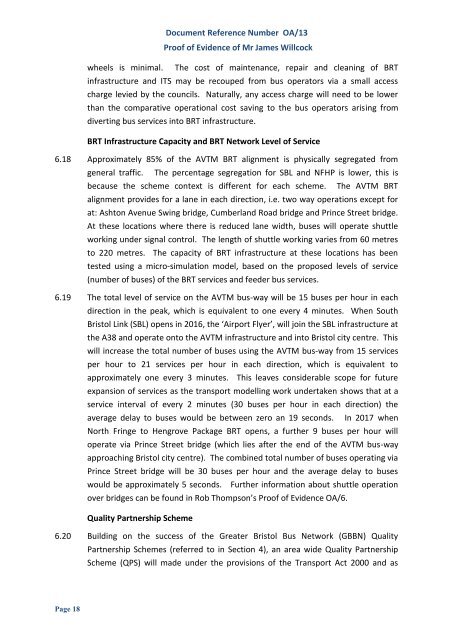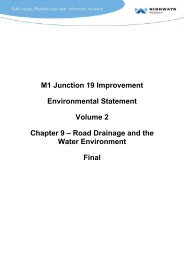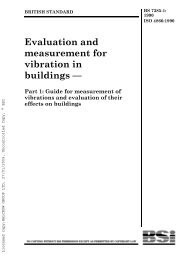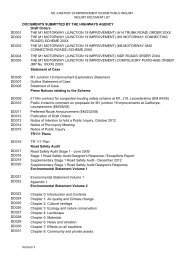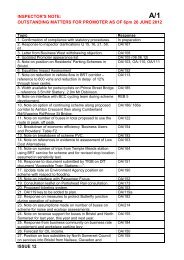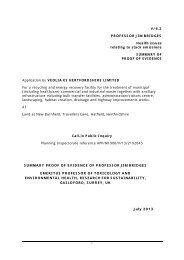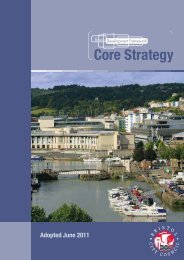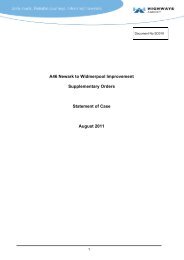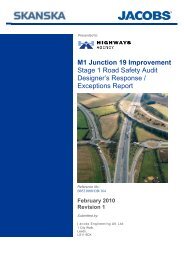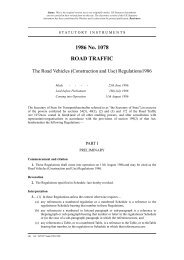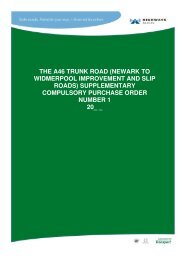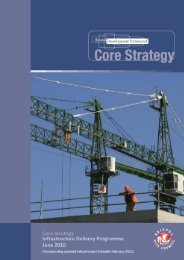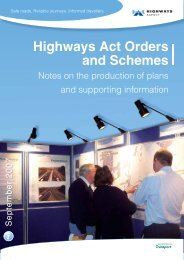Proof of Evidence of Mr James Willcock
Proof of Evidence of Mr James Willcock
Proof of Evidence of Mr James Willcock
Create successful ePaper yourself
Turn your PDF publications into a flip-book with our unique Google optimized e-Paper software.
Document Reference Number OA/13<br />
<strong>Pro<strong>of</strong></strong> <strong>of</strong> <strong>Evidence</strong> <strong>of</strong> <strong>Mr</strong> <strong>James</strong> <strong>Willcock</strong><br />
wheels is minimal. The cost <strong>of</strong> maintenance, repair and cleaning <strong>of</strong> BRT<br />
infrastructure and ITS may be recouped from bus operators via a small access<br />
charge levied by the councils. Naturally, any access charge will need to be lower<br />
than the comparative operational cost saving to the bus operators arising from<br />
diverting bus services into BRT infrastructure.<br />
BRT Infrastructure Capacity and BRT Network Level <strong>of</strong> Service<br />
6.18 Approximately 85% <strong>of</strong> the AVTM BRT alignment is physically segregated from<br />
general traffic. The percentage segregation for SBL and NFHP is lower, this is<br />
because the scheme context is different for each scheme. The AVTM BRT<br />
alignment provides for a lane in each direction, i.e. two way operations except for<br />
at: Ashton Avenue Swing bridge, Cumberland Road bridge and Prince Street bridge.<br />
At these locations where there is reduced lane width, buses will operate shuttle<br />
working under signal control. The length <strong>of</strong> shuttle working varies from 60 metres<br />
to 220 metres. The capacity <strong>of</strong> BRT infrastructure at these locations has been<br />
tested using a micro-simulation model, based on the proposed levels <strong>of</strong> service<br />
(number <strong>of</strong> buses) <strong>of</strong> the BRT services and feeder bus services.<br />
6.19 The total level <strong>of</strong> service on the AVTM bus-way will be 15 buses per hour in each<br />
direction in the peak, which is equivalent to one every 4 minutes. When South<br />
Bristol Link (SBL) opens in 2016, the ‘Airport Flyer’, will join the SBL infrastructure at<br />
the A38 and operate onto the AVTM infrastructure and into Bristol city centre. This<br />
will increase the total number <strong>of</strong> buses using the AVTM bus-way from 15 services<br />
per hour to 21 services per hour in each direction, which is equivalent to<br />
approximately one every 3 minutes. This leaves considerable scope for future<br />
expansion <strong>of</strong> services as the transport modelling work undertaken shows that at a<br />
service interval <strong>of</strong> every 2 minutes (30 buses per hour in each direction) the<br />
average delay to buses would be between zero an 19 seconds. In 2017 when<br />
North Fringe to Hengrove Package BRT opens, a further 9 buses per hour will<br />
operate via Prince Street bridge (which lies after the end <strong>of</strong> the AVTM bus-way<br />
approaching Bristol city centre). The combined total number <strong>of</strong> buses operating via<br />
Prince Street bridge will be 30 buses per hour and the average delay to buses<br />
would be approximately 5 seconds. Further information about shuttle operation<br />
over bridges can be found in Rob Thompson’s <strong>Pro<strong>of</strong></strong> <strong>of</strong> <strong>Evidence</strong> OA/6.<br />
Quality Partnership Scheme<br />
6.20 Building on the success <strong>of</strong> the Greater Bristol Bus Network (GBBN) Quality<br />
Partnership Schemes (referred to in Section 4), an area wide Quality Partnership<br />
Scheme (QPS) will made under the provisions <strong>of</strong> the Transport Act 2000 and as<br />
Page 18


